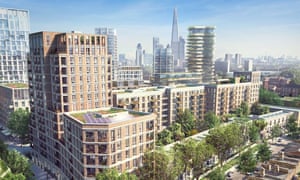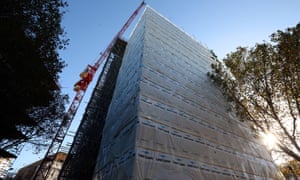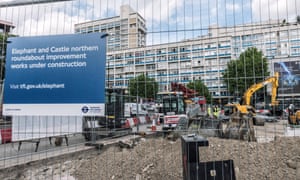Revealed: how developers exploit flawed planning system to minimise affordable housing
The release of a ‘viability assessment’ for one of London’s most high-profile developments – seen exclusively by the Guardian – sheds new light on how developers are taking advantage of planning laws to ramp up their returns

Visualisation of the £1.2bn Elephant Park development, on the site of the old Heygate Estate. Illustration: Lend Lease Corporation (2014)
Golden towers emerge from a canopy of trees on a hoarding in Elephant and Castle, snaking around a nine-hectare strip of south London where soon will rise “a vibrant, established neighbourhood, where everybody loves to belong”. It is a bold claim, given that there was an established neighbourhood here before, called the Heygate Estate – home to 3,000 people in a group of 1970s concrete slab blocks that have since been crushed to hardcore and spread in mounds across the site, from which a few remaining trees still poke.
Everybody might love to belong in Australian developer Lend Lease’s gilded vision for the area, but few will be able to afford it. While the Heygate was home to 1,194 social-rented flats at the time of its demolition, the new £1.2bn Elephant Park will provide just 74 such homes among its 2,500 units. Five hundred flats will be “affordable” – ie rented out at up to 80% of London’s superheated market rate – but the bulk are for private sale, and are currently being marketed in a green-roofed sales cabin on the site. Nestling in a shipping-container village of temporary restaurants and pop-up pilates classes, the sales suite has a sense of shabby chic that belies the prices: a place in the Elephant dream costs £569,000 for a studio, or £801,000 for a two-bed flat.
None of this should come as a surprise, being the familiar aftermath of London’s regenerative steamroller, which continues to crush council estates and replace them with less and less affordable housing. But alarm bells should sound when you realise that Southwark council is a development partner in the Elephant Park project, and that its own planning policy would require 432 social-rented homes, not 74, to be provided in a scheme of this size – a fact that didn’t go unnoticed by Adrian Glasspool, a former leaseholder on the Heygate Estate.
In May 2012, shortly after Lend Lease submitted its planning application, Glasspool lodged a freedom of information request to see the figures used to justify this apparent breach of policy. Now, after a three-year battle of tribunals and appeals, during which Southwark council fought vociferously and spent large amounts of taxpayers’ money to keep the details secret, a redacted version of the developer’s “financial viability assessment” has finally materialised – a document that justifies why the planning policy cannot be met.
The Heygate had 1,194 social-rented flats at the time of its demolition. Elephant Park will provide 74 such homes
Seen exclusively by the Guardian, the document sheds new light on why so little affordable housing is being built across England; why planning policy consistently fails to be enforced; and why property developers are now enjoying profits that exceed even those of the pre-crash housing bubble.
In the last decade, London has lost 8,000 social-rented homes. Under the Tory-led coalition, the amount of affordable housing delivered across the country fell by a third – from 53,000 homes completed in 2010 to 36,000 in 2014. Much of the reason lies hidden in these developers’ viability assessments and the dark arts of accounting, which have become all-powerful tools in the way our cities are being shaped.
It is a phenomenon, in the view of housing expert Dr Bob Colenutt at the University of Northampton, that “threatens the very foundations of the UK planning system”; a legalised practice of fiddling figures that represents “a wholesale fraud on the public purse”. What was once a statutory system predicated on ensuring the best use of land has become, in Colenutt’s and many other experts’ eyes, solely about safeguarding the profits of those who want to develop that land.
Under Section 106, also known as “planning gain”, developers are required to provide a certain proportion of affordable housing in developments of more than 10 homes, ranging from 35–50% depending on the local authority in question. Developers who claim their schemes are not commercially viable, when subject to these obligations, must submit a financial viability assessment explaining precisely why the figures don’t stack up.
In simple terms, this assessment takes the total costs of a project – construction, professional fees and profit – and subtracts them from the total projected revenue from selling the homes, based on current property values. What’s left over is called the “residual land value” – the value of the site once the development has taken place, which must be high enough to represent a decent return to the landowner.
It is therefore in the developer’s interest to maximise its projected costs and minimise the projected sales values to make its plans appear less profitable. With figures that generate a residual value not much higher than the building’s current value, the developer can wave “evidence” before the council that the project simply “can’t wash its face” if it has to meet an onerous affordable housing target – while all the time safeguarding their own profit.
According to Glasspool, the most striking thing about the Heygate viability assessment “is that it has nothing to do with the scheme’s viability at all, and everything to do with its profitability for the developer”. It is also all perfectly legal.
Within the pages of calculations, produced for Lend Lease by property agent Savills, the level of “acceptable” profit is fixed at 25% – a proportion that equates to around £300m. Southwark council commissioned an independent appraisal of this viability assessment from the government’s district valuer service (which was also revealed as part of the disclosure). The appraisal clearly highlights this 25% profit level as a concern, noting that “most development schemes when analysed following completion average out below 15%”. The difference represents more than £100m that could have been spent on affordable housing – yet the 25% profit level remains unchallenged.
A second concern was raised over the estimation of Elephant Park’s total value upon completion. The predicted sales values are set at an average of £600 per sq ft in the viability assessment, a figure it says is derived from “comparable” developments. Yet a close look at the appendix of these “comparable” schemes includes such properties as an ex-council flat in an estate on the fringes of Camberwell – a far cry from the glistening towers of Elephant Park.
On a recent visit to Lend Lease’s rustic sales cabin, I was greeted by a helpful assistant who said I’d have to hurry if I wanted to snap up one of the two remaining £2.5m penthouses in the One The Elephant development across the road, before handing me a price list for the new Elephant Park flats. They are currently selling for an average of more than £1,000 per sq ft: two-thirds more than the figure suggested in the viability assessment. In 10 years’ time, when the later phases are on the market, values are likely to have skyrocketed further. Yet the number of social units will remain at 74.
Once again, the district valuer queried these figures, suggesting a review mechanism be put in place to allow the amount of affordable housing to increase if sales turned out better than predicted. Such a mechanism is standard practice for a project of this scale, planned to be built out over the next 15 years. Further west along the Thames at Nine Elms – London’s new muscle beach for buildings, with its emerging skyline of steroidal towers – Wandsworth council has recently secured an extra £40m windfall for affordable housing through such a mechanism, as a result of rocketing sales values on the Embassy Gardens scheme.
Southwark’s planning officer, however, didn’t see the need for such a condition at the Elephant. “A very significant economic upturn would be required,” he noted in his report, “to secure any increase in the quantum of affordable housing.”
A further question mark hangs over just how affordable the project’s “affordable housing” will be. Southwark’s planning policy states that all developments at Elephant and Castle must provide 35% affordable housing, split 50/50 between shared ownership (also known as “part-buy, part rent”) and social-rented. This was also a condition of the Regeneration Agreement between Southwark and Lend Lease.
Yet, in the viability assessment, not only does Lend Lease argue that it can provide just 25% affordable, but also that all one- and two-bed social-rented units in the scheme must be “affordable rent” – capped at 50% of the market rate – to make the project stack up. The difference is crucial: whereas social rent is pegged to average income and remains relatively stable, affordable rent is pegged to market forces, so does not.
What does that mean in monetary terms? In Southwark’s Affordable Rent Study, updated in December last year, the average social rent for one- and two-beds in the area was £97pw and £111pw respectively. Under Lend Lease’s “affordable” regime, managed by housing association London & Quadrant (L&Q), 50% of the market rate equates to £150pw and £184pw respectively. Across the board, that means the affordable units will be, on average, 37% higher than social rents would have been – and who knows what the market rate will be by the time the scheme is completed in 2025?
As for the shared-ownership units, L&Q’s current price list reveals that, to be eligible for the cheapest one-bed home, you must have a minimum household income of £57,500 – when the average household income in that part of Southwark is £24,324.
Source:- There is even more of this article here:-http://www.theguardian.com/cities/2015/jun/25/london-developers-viability-planning-affordable-social-housing-regeneration-oliver-wainwright



No comments:
Post a Comment